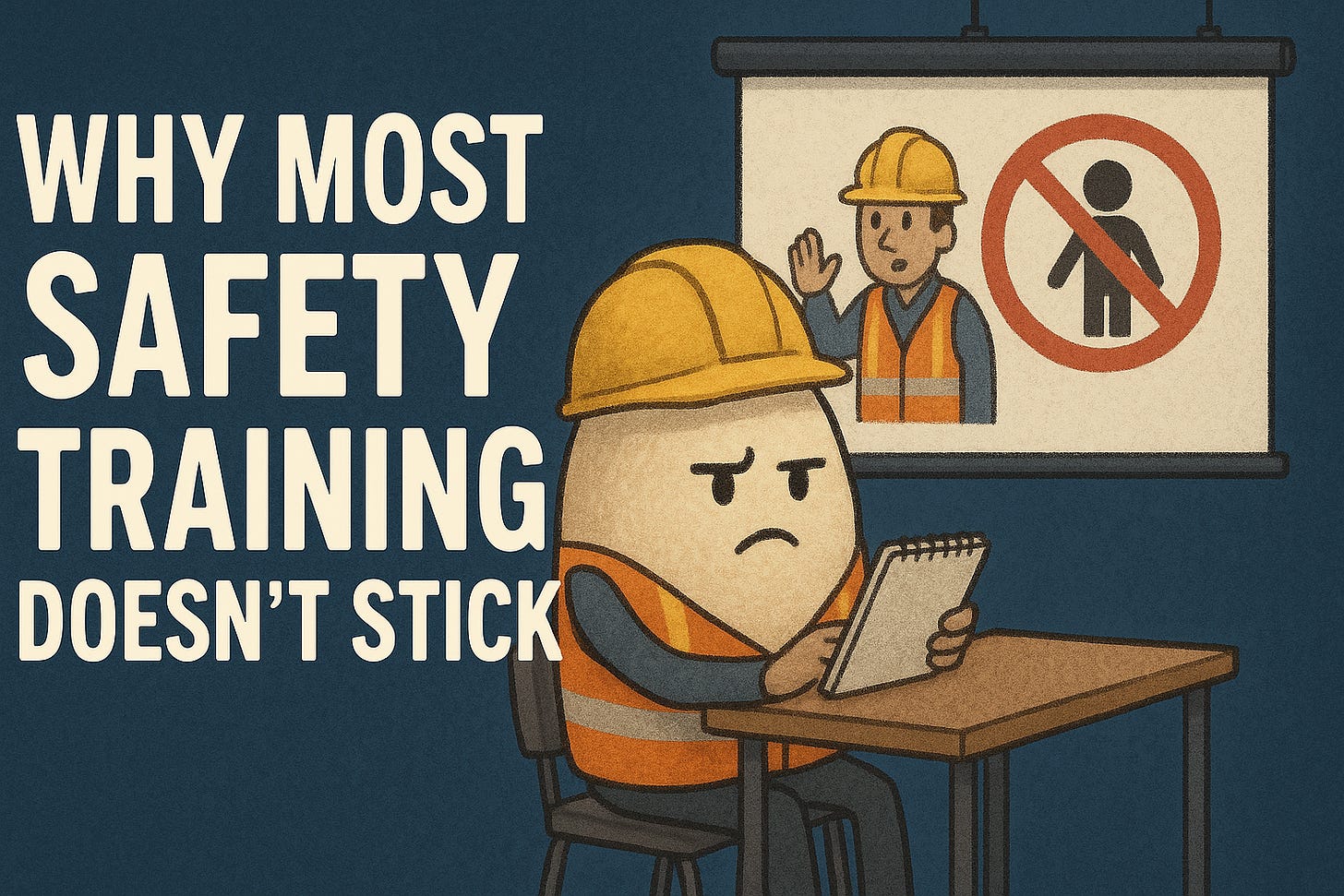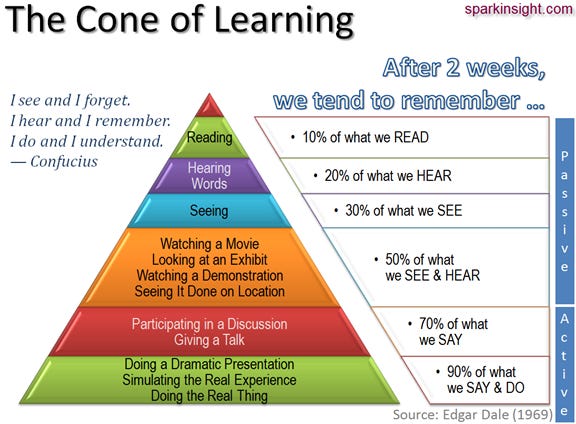Why Most Safety Training Doesn’t Stick
And what Dale's Cone of Learning Teaches us About Fixing It
Hey there,
Welcome to this week’s edition of Safety Pro Weekly. This week we’re looking at safety training and how we can make it so much better.
Here’s a harsh truth:
24 hours after your employees have completed their safety training, they’ve already forgotten more than half of it.
How can this be?
In this issue:
The way most Health and Safety training is boring, passive and ineffective.
Dale’s Cone of Learning established a continuum of least effective to most effective ways to deliver training in ways that people actually engage with and remember.
Moving your training strategy down the cone towards more active and engaging training strategies dramatically improves retention.
Combinations of various methods work together and help reinforce learning outcomes.
Way back in the 1800s, researcher Hermann Ebbinghaus identified what he called the ‘Forgetting Curve’, which demonstrates that humans rapidly forget information presented to them (50-70% after 24 hours, up to 90% within a week) if the message is not reinforced.
This has major implications for effectiveness of your health and safety training, or lack thereof …
The kind of boring, passive, text heavy slideshows you’re probably using now for safety training might allow you to check the box in terms of meeting compliance requirements, but studies show it’s not effective for real learning and this lack of retention puts workers, and your business, at risk.
To make your training effective, you need to deliver it in a way that people actually learn.
Dale’s Cone of Learning
In the 1940s, education researcher Edgar Dale developed the Cone of Learning.
This model shows that people retain information more readily when they are actively involved, rather than just passively receiving information.
Dale created a hierarchy of learning experiences that moves from abstract to concrete. The more abstract the training stye, the less effective it is at getting students to retain information.
Let’s look at the model and training options from least effective to most effective:
1. Verbal Symbols: This is the most passive and least effective method. It involves listening to lectures and reading text.
2. Visual Symbols: Slightly better for retention are visual symbols such as charts, diagrams and graphs. These add clarity and are slightly more engaging, but are still mostly abstract and don’t encourage retention.
3. Recordings, Audio, Still Pictures. Next up we have audio, photos and still pictures. This increases the level of context, but are still not engaging and interactive.
4. Motion Pictures. Motion pictures make things more real. These are more engaging than still photos or audio and begin to improve student’s retention level.
5. Exhibits, Demonstrations and Field Trips. These provide more direct experiences in more realistic settings and are very helpful in getting students engaged and helping them retain information.
6. Dramatized Experiences. Role play, reenactments and simulations really get learners engaged and help them retain information. There’s a reason NASA has astronauts go through repeated as real as possible simulations here on earth before sending them up into space.
7. Direct, Purposeful Experience. Hands on practice and, in particular, teaching others is the best way to learn if you’re looking for information retention and recall. Nothing beats doing the real task or showing it to others for promoting real understanding of the material.
How to fix it: Look For Ways to Move Workers Down the Cone
So, if you want to level up the effectiveness of your safety training, the key is to move your training down the pyramid towards more effective ways to deliver the information.
Here’s how it looks in practice:
Verbal Symbols: Listening to safety reminders, or lectures.
Visual Symbols: Posters showing proper lifting, PPE, machine guarding.
Recordings, Audio, Still Pictures: Spot hazards in photos, diagrams, graphs.
Motion Pictures: Safety videos.
Exhibitions, demonstrations: Instructor-led fire extinguisher training, spill cleanup demonstrations, forklift walk-arounds.
Dramatized Experiences: Mock emergency drills, role-playing accident response scenarios.
Direct, Purposeful Experience: Teaching others, having workers lead toolbox talks or mentor new employees.
It’s important to keep in mind that information is best delivered in different ways. Just because the method of visual symbols is higher up the cone, for example, doesn’t mean there is no place for posters and signage. It just means that you shouldn’t rely only on those methods entirely. Spicing up your information delivery with more memorable approaches helps the information stick in employee’s minds.
For example, while you should still post signs of your evacuation routes (ie. visual symbols), running an active evacuation drill where everyone participates (ie. dramatized experience) will leave a more lasting impression to support that information.
The closer training gets to real-world practice, the more workers remember, and the more likely they are to act safely when it matters.
The best safety training isn’t about how much information you deliver—it’s about how much workers actually retain. By shifting from passive presentations to active, hands-on experiences, safety professionals can create training that sticks, changes behavior, and ultimately prevents injuries.
That’s it for this week.
Safety Pro Weekly is published every Tuesday on LinkedIn and Substack.
Let me know in the comments some of the ways you make your safety training more effective.
Cheers,
Dan.




